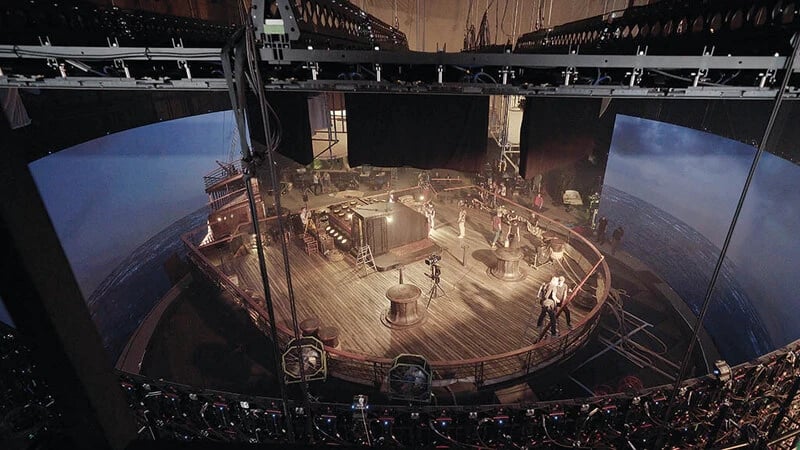One of the biggest challenges in film and television production is creating realistic background environments. In the past, this was chiefly achieved through filming on location or constructing elaborate sets and backdrops. The introduction of green screens helped film and television productions achieve more cost- and time-effective results, digitally adding environments in post-production (using visual effects). Today, with the advancement of real-time technology, a new option has emerged: virtual production LED walls. But which is better?
LED Wall vs. Green Screen - What's Better?
LED walls offer some unique benefits over traditional green screens. However, green screens still have a place in the industry. So, which is better for filmmakers? This article will compare green screens vs LED walls, looking at how both are used in film and television productions.
What is a green screen?
Green screen technology has been around for over 100 years but was popularized for film in the 1980s by procedures used in The Empire Strikes Back.
The green screen process involves a large green-colored (sometimes blue) background placed behind the action. When the production footage goes to post-production, visual effects artists overlay background scenes, animations, and effects in these green areas. When used as a backdrop, a green screen can be replaced with fully CGI environments and sets or a filmed real-life location where live shooting would not be possible (like in the middle of an ocean).
This technology can also be used to “remove” other elements of an actor or from the scene, making it easy to replace them with CGI elements in post-production. An actor can wear green screen material on their body so it can be replaced with, for example, an alien body, or to remove a specific body part altogether (like using CGI to portray an amputated limb on a character).
Superman vs. Justice League: example of green screens used for scene backgrounds and to remove supporting crew, wires, etc., from shots. (Notice the comparison previsualization 3D animations.)
What is an LED wall?
An LED wall, known as a Volume, is a large curved screen comprised of thousands of LEDs that surround actors, props, and (smaller) practical sets. Coincidently, LED walls were also popularized by the Star Wars franchise—being used extensively in the hit TV series The Mandalorian.

Artists use real-time 3D game engines like Unreal Engine to create the “worlds” of the scene and project them live on these screens, behind the actors and foreground set pieces, with virtual cameras that move to match the live-action cameras.
These LED walls provide more realistic and adjustable lighting for the scene, minimizing the need for large, complicated lighting set-ups on set. Real-time 3D artists are on-set with the director, actors, and crew during principal photography and can make real-time adjustments to the digital “world” rather than waiting for post-production.
Behind the scenes of the 2017 series Star Trek: Discovery using an LED wall
Comparison: Green screen vs. LED wall
Both filmmaking technologies are widely used today, and each has ideal use cases depending on the creative brief. Here is a comparison summary of the two technologies:
|
Green Screen |
LED Wall |
|
|
Usage |
Backgrounds and CGI components on actor and foreground elements. |
Scene backgrounds that track with live-action cameras to create parallax. |
|
Set prep |
Setting up the actual green screen takes less time than a Volume. However, significant time is needed to prep lighting and additional background sets, which also need to be "recorded" as reference so they can be matched in post-production. |
While setting up the Volume is more technical and time-consuming, minimal day-of set-up work is required because real-time artists have created the digital environments in advance of principal photography. |
|
Actor & Director support |
Actors and directors need to pretend what their scene looks like and envision how it will look with visual effects added. |
Actors are placed in a more fully immersive environment where they can see the full background. This provides directors with a more complete visualization of the scene on set and what the final product will look like. |
|
Lighting |
Physical, on-set, and often complicated lighting set-ups. |
Scene lighting is managed through real-time LED screens. |
|
Creative workflows |
A more linear production workflow. Aside from storyboarding and previsualization, most VFX is done in post-production. Green screens are also used for motion capture (Simulcam) filming, which helps filmmakers better visualize a scene. |
Much of the world building is done before principal photography. Real-time changes (such as adjusting the lighting to work better with the live actors and on-set pieces, grading tweaks, and swapping out assets or scenes) can be performed on-site during filming. |
|
Time & effort |
Easier to assemble but requires more time on set and during pre and post-production. It's harder to replicate if a reshoot is needed. In post-production, green screens can cause color spill on the actor and props, which need to be carefully removed. |
While real-time 3D artists will spend more time in pre-production they streamline the filming and post-production processes. Assets created in pre-production can often be re-used in post, further reducing time and costs. |
|
Cost |
Costs of building a green screen stage are less expensive. They can be set up on any stage and are often preferred (and less expensive) for larger scenes, such as when four-story ceilings are needed for large action sequences like in Avengers End Game. |
Cost of building a volume stage is more expensive due to the cost of the panels, cables, and software to make it all work. Also, additional costs to hire staff to ensure it doesn’t break down (as filming stoppages due to a broken pixel in a screen can be costly too). |

LED wall used in the upcoming Netflix TV series 1899
How to move into virtual production
As virtual production workflows gain in popularity, the world will need more skilled real-time 3D technical artists for every stage of a production.
As an Unreal Academic Partner and one of the Top 50 Best Creative Media & Entertainment Art Schools in the World, CG Spectrum is excited to offer career training in real-time 3D using Unreal Engine. You'll learn storytelling, world building, lighting, and camera essentials to create film-quality shots for virtual production.
Learn real-time 3D at CG Spectrum
If you are a professional who wants to make a move into the future of filmmaking and content creation, CG Spectrum can teach you Unreal Engine from the ground up, in our specialized real-time 3D courses. Take your career to new realms with CG Spectrum!

Related Links




